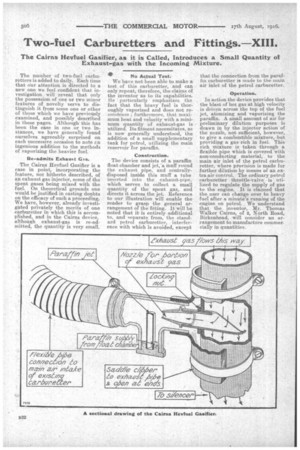Two-fuel Carburetters and Fittings.—XIII.
Page 4

If you've noticed an error in this article please click here to report it so we can fix it.
The Cairns Heyfuel Gasifier, as it is Called, Introduces a Small Quantity of Exhaust-gas with the Incoming Mixture.
The number of two-fuel carburetters is added to daily. Each time that our attention is directed to a new one we feel confident that investigation will reveal that only the possession of one or two minor features of novelty serve to distinguish it from some one or other of those which we have previously examined, and possibly described in these pages. Although this has been the case in one or two instances, we have generally found ourselves agreeably surprised on each successive occasion to note nil ingenious addition to the methods of vaporizing the heavier fuel.
Re-admits Exhaust Gas.
• The Cairns Hevfuel Gasifier is a case in point, incorporating the feature, not hitherto described, of an exhaust gas injector, some of the spent gases being mixed with the fuel. On theoretical grounds one would be justified in casting doubts on the efficacy of such a proceeding. We have, however, already investigated privately the merits of one carburetter in which this is accomplished, and in the Cairns device, although exhaust-gas is re-admitted, the quantity is very small.
• No Adual Test.
We have not been able to make a test of this carburetter, and can only repeat, therefore, the claims of the inventor as to its capabilities. He particularly emphasizes the fact that the heavy fuel is thoroughly vaporized and does not reeondense ; furthermore, that maximum heat and velocity with a minimum quantity of exhaust-gas is utilized. Its fitment necessitates, as is now generally understood, the addition of a small supplementary tank for petrol, utilizing the main reservoir for paraffin.
Construction.
The device consists of a paraffin float chamber and jet,--a Muff round the exhaust pipe, and centrallydisposed inside this muff a tube inserted into the exhaust-pipe, which serves to collect a small quantity of the• spent gas, and directs it across the jet. Reference to our illustration will enable the reader to grasp the general arrangement of the fitting. It will be noted that it is entirely additional to, and separate from, the standard petrol carburetter, interference with which is avoided, except that the connection from the paraffin carburetter is made to the main air inlet of the petrol carburetter.
Operation.
In action the device provides that the blast of hot gas at high velocity is driven across the top of the fuel jet, atomizing and vaporizing the paraffin. A small amount of air for preliminary dilution purposes is drawn in by the injector action of the nozzle, not sufficient, however, to give a combustible mixture, but providing a gas rich in fuel. This rich mixture is taken through a flexible pipe which is covered with non-conducting material, to the main air inlet of the petrol carburetter, where provision is made for further dilution by means of an extra air control. The ordinary petrol carburetter throttle-valve is utilized to regulate the supply of gas to the engine. It is claimed that the user can change over to heavy fuel after a minute's running of the engine on petrol. We understand that the inventor, Mr. Thomas Walker Cairns, of 2, North Road, Birkenhead, will consider an arrangement to manufacture comm cially in quantities.




















